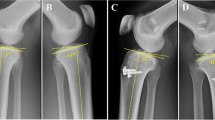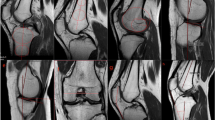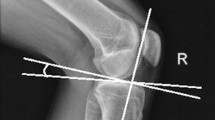Abstract
Purpose
The purpose of this study was (1) to determine differences in posterior tibial slope (PTS) between subjects who underwent ACL reconstruction following a non-contact ACL injury and a matched control uninjured group and (2) to investigate gender differences between ACL-injured subjects and gender-matched controls.
Methods
A retrospective chart review was conducted of all 316 ACL-deficient patients at a large regional academic teaching hospital. A control group was established searching the database of the same hospital for subjects who underwent knee radiographs for acute knee complaints with no ACL injury. Subjects (n = 272; males n = 199; females n = 73) were included if a non-contact mechanism could be established. Exclusion criteria included previous ipsilateral knee injury and/or knee previous surgery. PTS was measured on a digitalized lateral radiograph using the axis of the posterior tibial cortex as a reference.
Results
There was a significant difference (P = 0.008) within the ACL injury group between males and females. There was no significant difference in the PTS angle between those patients with an ACL injury (5.8 ± 3.5 degrees) and the uninjured control group (5.6 ± 3.2 degrees), or between the male ACL injury patients (5.5 ± 3.4) and their control group (5.8 ± 3.1). However, there was a significant difference between the female ACL injury patients (6.7 ± 3.7) and their uninjured control group (5.0 ± 3.4) (P = 0.004).
Conclusion
The results of this study suggest that increased posterior tibial slope appears to contribute to non-contact ACL injuries in females, but not in males.
Level of evidence
Case–control study, Level III.

Similar content being viewed by others
References
Alentorn-Geli E, Myer GD, Silvers HJ, Samitier G, Romero D, Lazaro-Haro C, Cugat R (2009) Prevention of non-contact anterior cruciate ligament injuries in soccer players. Part 1: mechanisms of injury and underlying risk factors. Knee Surg Sports Traumatol Arthrosc 17:705–729
Bach LA, Sharpe K (1989) Sample size for clinical and biological research. Aust N Z J Med 19:64–68
Bisson LJ, Gurske-DePerio J (2010) Axial and sagittal knee geometry as a risk factor for noncontact anterior cruciate ligament tear: a case-control study. Arthroscopy 26:901–906
Boden BP, Breit I, Sheehan FT (2009) Tibiofemoral alignment: contributing factors to noncontact anterior cruciate ligament injury. J Bone Joint Surg 91:2381–2389
Brandon ML, Haynes PT, Bonamo JR, Flynn MI, Barrett GR, Sherman MF (2006) The association between posterior-inferior tibial slope and anterior cruciate ligament insufficiency. Arthroscopy 22:894–899
Brazier J, Migeaud H, Gougeon F, Cotten A, Fontaine C, Duquennoy A (1996) Evaluation of methods for radiographic measurement of the tibial slope. A study of 83 healthy knees. Rev Chir Orthop Reparatrice Appar Mot 82:195–200
Chan SC, Seedhom BB (1995) The effect of the geometry of the tibia on prediction of the cruciate ligament forces: a theoretical analysis. Proc Inst Mech Eng 209:17–30
DeJour H, Walch G, Chambat P, Ranger P (1988) Active subluxation in extension: a new concept of study of the ACL-deficient knee. Am J Knee Surg 1:204–211
Fening SD, Kovacic J, Kambic H, McLean S (2008) The effects of modified posterior tibial slope on anterior cruciate ligament strain and knee kinematics: a human cadaveric study. J Knee Surg 2:205–212
Frick H, Leonhardt H, Starck D (1992) Spezielle anatomie. Stuttgart Thieme 4:202–203
Genin P, Weill G, Julliard R (1993) The tibial slope. Proposal for a measurement method. J Radiol 74:27–33
Giffin JR, Vogrin TM, Zantop T, Woo SL, Harner CD (2004) Effects of increasing tibial slope on the biomechanics of the knee. Am J Sports Med 32:376–382
Granan LP, Forssblad M, Lind M, Engebretsen L (2009) The Scandinavian ACL registries 2004–2007: baseline epidemiology. Acta Orthop 80:563–567
Griffin LY, Agel J, Albohm MJ, Arendt EA, Dick RW, Garrett WE, Garrick JG, Hewett TE, Huston L, Ireland ML, Johnson RJ, Kibler WB, Lephart S, Lewis JL, Lindenfeld TN, Mandelbaum BR, Marchak P, Teitz CC, Wojtys EM (2000) Noncontact anterior cruciate ligament injuries: risk factors and prevention strategies. J Am Acad Orthop Surg 8:141–150
Hashemi J, Chandrashekar N, Mansouri H, Gill B, Slauterbeck JR, Schutt RC (2010) Shallow medial tibial plateau abd steep medial and lateral tibial slopes. New risk factors for anterior cruciate ligament injuries. Am J Sports Med 38:54–62
Hohmann E, Bryant A, Reaburn P, Tetsworth K (2010) Does posterior tibial slope influence knee functionality in the anterior cruciate ligament–deficient and anterior cruciate ligament-reconstructed knee? Arthroscopy 26:1496–1502
Hohmann E, Bryant AL (2007) Closing or opening wedge high tibial osteotomy: watch out for the slope. Operat Techn Orthop 17:17–38
Liu W, Maitland ME (2003) Influence of anthropometric and mechanical variations on functional instability in the ACL deficient knee. Ann Biomed Eng 2003 31:1153–1161
McNair PJ, Wood GA, Marshall RN (1992) Stiffness of the hamstring muscles and its relationship to function in anterior cruciate deficient individuals. Clin Biomech 7:131–137
Meister K, Talley MC, Horodyski MB, Indelicato PA, Hartzel JS, Batts J (1998) Caudal slope of the tibia and its relationship to noncontact injuries to the ACL. Am J Knee Surg 11:217–219
O’Connor J, Shercliff TL, Biden E, Goodfellow JW (1989) The geometry of the knee in the sagittal plane. Proc Inst Mech Eng H 203:223–233
Olsen OE, Myklebust G, Engebretsen L, Bahr R (2004) Injury mechanisms for anterior cruciate ligament injuries in team handball: a systematic video analysis. Am J Sports Med 32:1002–1012
Parkkari J, Pasanen K, Mattila VM, Kannus P, Rimpelä A (2008) The risk for a cruciate ligament injury of the knee in adolescents and young adults: a population-based cohort study of 46 500 people with a 9 year follow-up. Brit J Sports Med 42:422–426
Sariali E, Catonne Y (2009) Modification of tibial slope after medial opening wedge osteotomy: clinical study and mathematical modeling. Knee Surg Sports Traumatol Arthrosc 17:1172–1177
Shao Q, MacLeod TD, Manal K, Buchanan TS (2011) Estimation of ligament loading and anterior tibial translation in healthy and ACL-deficient knees during gait and the influence of increasing tibial slope using EMG-driven approach. Ann Biomed Eng 39:110–121
Shelbourne KB, Kim HJ, Sterett WI, Pandy MG (2011) Effect of posterior tibial slope on knee biomechanics during functional activity. J Orthop Res 29:223–231
Stijak L, Herzog RF, Schai P (2008) Is there an influence of the tibial slope of the lateral condyle on the ACL lesion? Knee Surg Sports Traumatol Arthrosc 16:112–117
Todd MS, Lalliss S, Garcia ES, DeBerardino TM, Cameron KL (2010) The relationship between posterior tibial slope and anterior cruciate ligament injuries. Am J Sports Med 38:63–67
Uhorchak JM, Scoville CR, Williams NW, Arciero RA, St. Pierre P, Taylor DC (2003) Risk factors associated with noncontact injury of the anterior cruciate ligament. Am J Sports Med 31:824–831
Conflict of interest
The authors declare that they have no conflict of interest.
Author information
Authors and Affiliations
Corresponding author
Rights and permissions
About this article
Cite this article
Hohmann, E., Bryant, A., Reaburn, P. et al. Is there a correlation between posterior tibial slope and non-contact anterior cruciate ligament injuries?. Knee Surg Sports Traumatol Arthrosc 19 (Suppl 1), 109–114 (2011). https://doi.org/10.1007/s00167-011-1547-4
Received:
Accepted:
Published:
Issue Date:
DOI: https://doi.org/10.1007/s00167-011-1547-4




